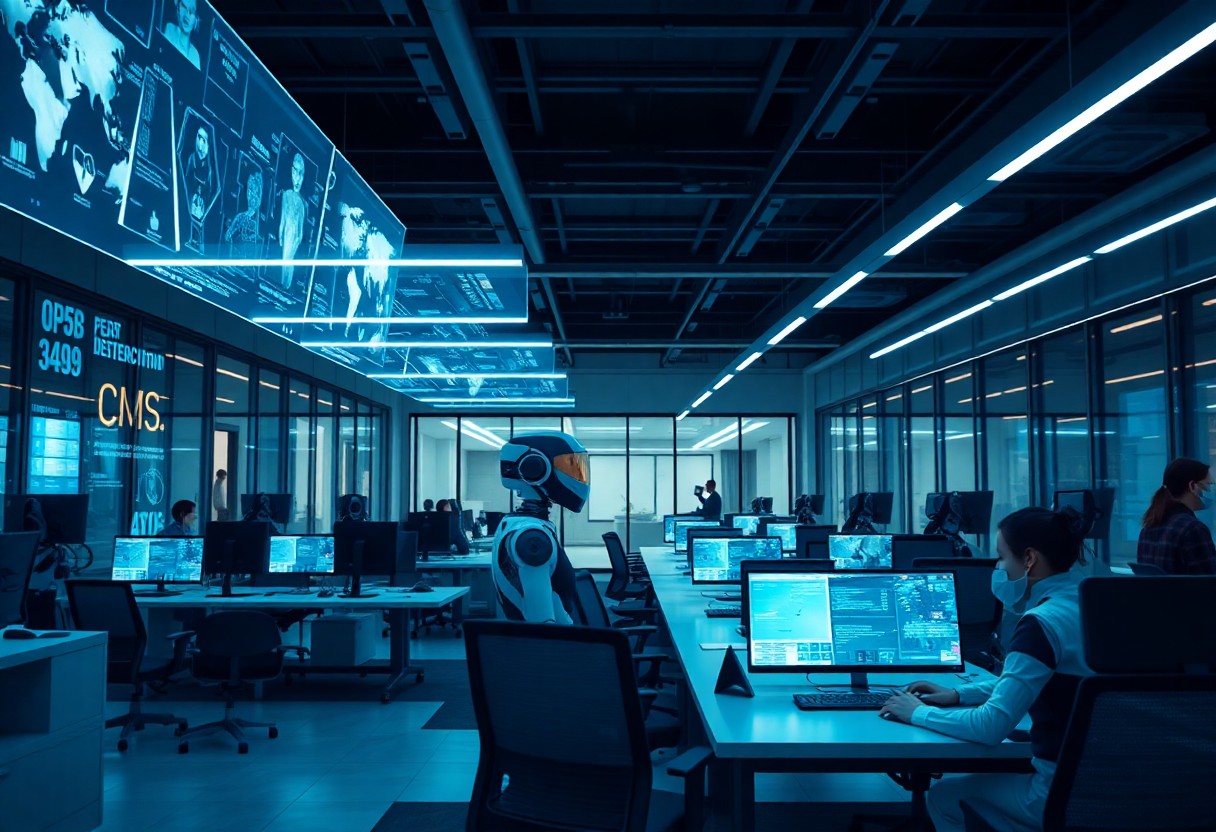Futuristic Technology – Enhancing Workplaces With Intelligent Solutions
Bridging The Gap – Smart Technology And Futuristic Innovations
April 4, 2025Low-Calorie Meal Prep – Strategies For Healthy Eating Success
April 7, 2025Over the past decade, futuristic technologies have transformed the way you approach your workplace, making it smarter, more efficient, and often safer. These intelligent solutions not only improve productivity but also enhance employee satisfaction by automating routine tasks and providing real-time insights. As you explore the integration of AI, robotics, and IoT within your work environment, it’s imperative to understand both the benefits and potential challenges to ensure your organization remains competitive and adaptable in an increasingly digital landscape. Embrace the future of work together with these innovative advancements.
The Role of Artificial Intelligence in Modern Workplaces
For businesses navigating today’s fast-paced environment, artificial intelligence (AI) has emerged as a game-changer in modern workplaces. By automating routine tasks and enhancing decision-making processes, AI empowers you to achieve higher productivity levels and focus on strategic initiatives. You will find that AI-driven tools facilitate collaboration and streamline workflows, ultimately leading to more effective operations and better outcomes for your organization.
AI-Powered Productivity Tools
Intelligence extends beyond mere automation; it also incorporates sophisticated tools that can significantly boost your productivity. AI-powered solutions streamline daily operations, allowing you to save valuable time and reduce errors. These tools include:
- Smart scheduling assistants
- Document automation
- Virtual project management teams
Advanced Data Analytics for Decision-Making
Behind effective decision-making lies the ability to analyze vast amounts of data. Advanced data analytics enables you to interpret complex datasets, helping you derive actionable insights that can drive strategic business moves. In your organization, utilizing AI-enhanced data analytics can result in:
- Improved forecasting accuracy
- Enhanced customer experience
- Informed risk management
| Benefits | Key Features |
|---|---|
| In-depth reporting | Predictive analytics |
| Cost savings | Real-time insights |
| Data visualization | User-friendly dashboards |
Analytics not only enhances your decision-making capabilities but also provides a comprehensive understanding of market trends and consumer behavior. By leveraging advanced analytics tools, you can identify opportunities that will propel your organization forward. This includes:
- Identifying customer preferences
- Recognizing market gaps
- Improving operational efficiency
| Data Sources | Insights Gained |
|---|---|
| Customer feedback | Product improvements |
| Sales data | Sales forecasting |
| Market research | Competitive analysis |

Automation Technologies Reshaping Industries
Any industry that embraces automation technology stands to gain significant advantages, from increased productivity to improved efficiency. By integrating advanced tools and systems, businesses can streamline processes, reduce operational costs, and enhance overall performance. As you navigate this new landscape, you’ll find that automation technologies are not just enhancing current practices but also creating new business opportunities and models that drive growth.
Robotic Process Automation (RPA)
One of the most transformative automation technologies in recent years is Robotic Process Automation (RPA), which allows you to automate repetitive and rule-based tasks. By implementing RPA, your organization can significantly reduce human errors, lower operational costs, and free up valuable employee time for more strategic initiatives. This change not only boosts productivity but also drives employee satisfaction as they can focus on more engaging tasks.
Intelligent Automation in Operations
Reshaping the operational landscape, Intelligent Automation combines RPA with artificial intelligence (AI) to create systems that can learn and adapt over time. This integration is changing how you operate by enabling more complex decision-making processes and reducing response times. Intelligent Automation empowers your team to enhance operational efficiency while minimizing risks and enhancing service quality.
Even organizations that implement Intelligent Automation see improvements in their workflow efficiency. By merging learning algorithms with RPA, your systems can analyze vast datasets and drive informed decisions. This capability leads to a dramatic reduction in processing times and improves accuracy in decision-making. As your organization transitions into this advanced form of automation, you’ll notice enhancements in customer satisfaction and a decrease in operational costs, fostering a more adaptive and responsive business environment. Embracing Intelligent Automation is not just an option; it is becoming crucial to remain competitive in today’s fast-paced market.
The Impact of Virtual and Augmented Reality
There’s a revolution happening in workplaces with the integration of virtual and augmented reality (VR and AR) technologies. These immersive experiences are transforming how tasks are performed, enhancing creativity, and improving productivity. By overlaying digital information onto the physical world, these solutions allow you to visualize complex concepts and engage in interactive problem-solving, thereby fostering innovation and collaboration among team members.
Enhancing Training and Development
After employees are trained through VR simulations, they experience a significant boost in confidence and skill retention. This technology allows you to engage in hands-on training scenarios without risk, facilitating experiential learning in a safe environment. With tailored programs designed to meet specific needs, you can ensure your workforce is equipped with the latest skills required for technological advancements.
Revolutionizing Remote Collaboration
Before, remote collaboration often felt disconnected and disjointed, but VR and AR innovations are bridging that gap. In a virtual space, you can interact with colleagues as if you are in the same room, boosting engagement and effective communication.
Another significant aspect of this transformation is how remote collaboration is enhanced through shared virtual environments. You can participate in real-time meetings, brainstorming sessions, and project developments, all while feeling truly interactive despite distances. This technology not only eliminates geographical barriers but also improves team dynamics; your colleagues can visualize concepts collaboratively, greatly reducing misunderstandings and streamlining project execution. Ultimately, leveraging these tools enhances your overall productivity and fosters a stronger team culture.
Smart Office Solutions
All businesses can benefit from implementing smart office solutions that leverage cutting-edge technology to enhance productivity, collaboration, and employee satisfaction. With intelligent tools at your disposal, such as advanced communication systems and smart meeting rooms, your workplace can become a hub of efficiency and innovation. These solutions not only streamline processes but also create an adaptable environment that supports the unique needs of your team.
Internet of Things (IoT) Integrations
An IoT integration allows you to connect various devices within your office, enabling seamless communication and automation. This connectivity can enhance your overall workplace experience by providing real-time data and insights about furniture usage, energy consumption, and even employee productivity patterns. As a result, you can make informed decisions that improve workflows and elevate employee engagement.
Energy Efficiency and Sustainability
Energy efficiency plays a vital role in modern workplaces and impacts both your bottom line and the environment. Sustainable practices, like optimizing energy use and reducing waste, not only lower operational costs but also enhance your company’s reputation. By investing in energy-efficient technologies, such as smart lighting and HVAC systems, you can significantly cut down on energy consumption and support your sustainability goals.
At the forefront of effective workplace solutions, the integration of energy-efficient technologies is vital for fostering a sustainable office environment. Utilizing smart sensors and automated systems can lead to a dramatic decrease in energy waste. Implementing such measures may not only enhance your operational efficiency but also reduce your carbon footprint, making a positive impact on the planet. As you prioritize these solutions, you’ll create a healthier workplace while boosting your brand’s appeal to environmentally-conscious clients and employees alike.
Cybersecurity in an Intelligent Workplace
To ensure a secure and efficient workplace, integrating robust cybersecurity measures is imperative. As 8 Ways Technology Will Shape the Workplace of the Future illustrates, the synthesis of intelligent solutions improves not only productivity but also the protection of sensitive data. Adopting advanced cybersecurity strategies will allow you to safeguard your organization against potential threats while embracing technological advancements.
Protecting Data with AI
Protecting your workplace’s data is increasingly easier with the integration of AI technologies. These intelligent systems can analyze patterns, detect anomalies, and respond to threats in real-time, providing you with a proactive defense. By implementing AI-driven solutions, you can enhance your overall cybersecurity posture and ensure your valuable data is safeguarded.
Emerging Threats and Solutions
After implementing advanced technologies, it’s necessary to stay vigilant against emerging threats that could compromise your workplace. Cybersecurity measures must evolve alongside these threats to maintain your defenses. Recognizing potential vulnerabilities and adapting quickly can help you minimize risks in your intelligent workplace.
Cybersecurity is a rapidly changing landscape where you must constantly be on guard against sophisticated attacks. As your workplace embraces technology, you could face new challenges like ransomware, phishing attacks, and data breaches. Employing *strong authentication methods*, leveraging *encryption*, and adopting an *incident response plan* are among the proactive steps you can take. Moreover, staying informed about the latest threats will empower you to enhance your workplace’s defenses and create a secure environment for both you and your team.
Future Trends in Workplace Technology
Now is the time to embrace the transformative power of technology in the workplace. As the environment shifts, you can expect innovative solutions to streamline processes, enhance collaboration, and elevate employee experiences. Future trends such as predictive analytics, machine learning, and the rise of remote and hybrid work environments will redefine how you approach your daily operations, fostering an era of increased efficiency and agility in your business.
Predictive Analytics and Machine Learning
Any business looking to enhance decision-making should consider the integration of predictive analytics and machine learning. These technologies utilize vast amounts of data to forecast trends and behaviors, enabling you to proactively address challenges and optimize your operations. With their ability to provide actionable insights, they empower you to make informed choices that drive success.
The Rise of Remote and Hybrid Work Environments
Work is no longer confined to traditional office spaces; the rise of remote and hybrid work environments presents a unique opportunity for your organization. Embracing this trend allows you to tap into a broader talent pool, while also enhancing employee satisfaction and work-life balance. However, it comes with its challenges, such as the potential for communication breakdowns and the need for effective collaboration tools. Ensuring your team remains connected and engaged will be crucial as you navigate this changing landscape.
Indeed, the shift to remote and hybrid work environments has reshaped how you manage your team and resources. This model offers remarkable flexibility and cost savings, allowing you to reduce overhead expenses while attracting a diverse range of talent. However, it also demands a focus on cybersecurity and maintaining corporate culture, as employees may feel disconnected without regular in-person interactions. By investing in the right technologies and support systems, you can foster a thriving remote workforce that enhances productivity and well-being.
Conclusion
To wrap up, embracing futuristic technology in your workplace can significantly enhance productivity and efficiency through intelligent solutions. By leveraging automation, artificial intelligence, and smart systems, you can streamline processes and improve decision-making. As you explore these innovations, consider how they can be tailored to meet your specific needs, ultimately fostering a more dynamic and adaptable work environment. Investing in these advancements not only prepares your organization for the future but also empowers your workforce to thrive in an ever-evolving landscape.
NEWSLETTER






